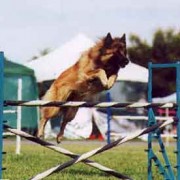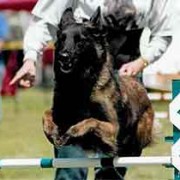Haute Volée Tervuren’s first litter was born February 2012. But what we have wanted to create, what we hope Haute Volée Tervuren is becoming, started many, many years before…
The Early Days
Rob and I have had Belgian Tervuren since 1985. My first Tervuren, Sam, was from show lines. He had temperament problems (he was a fear biter). I was young and my breeder, who lived 500 miles away, didn’t give me very good advice about him. Luckily I learned about the local terv club and got help from them, and some of them referred me to professional behaviorists. But finally, after much behavioral counseling and lifestyle management, we sadly decided to put Sam to sleep when he was just seven years old. This was the hardest thing I’ve ever done: to put down a healthy dog in the prime of his life. But his head wasn’t right. And I swore from that moment on that temperament would be my #1 priority, in the dogs I sought to own, and in any dog I might one day produce. And I promised myself I would be available and helpful to anyone who ever got a dog from me.
Before Sam died, Rob and I had already gotten another terv, a young female who became ADCh Uptempo Nikita CD. She was the first terv to achieve the USDAA ADCh (jumping at 30 inches even though in AKC she only just had to jump 20 inches). She had a solid temperament and lived 15 happy years. She was Rob’s first competition dog in the new sport of agility; Kita and Nancy Gyes’ Scud debuted at the same Haute Dawgs trial in Placerville, we have cute video of everyone doing awkward early agility.
Since Kita had been purchased to be Rob’s dog, though, I longed for a terv of my own again. I got another show line terv, “Maia.” She got her TD at 8 months, and was a delight to train in agility: smart, happy, biddable. But at around 10 months of age, she developed auto-immune mediated polyarthritis. We spent a lot of time trekking up to the UC Davis Veterinary Medical Teaching Hospital, and as her auto-immune disease progressed (it eventually attacked her kidneys and her bone marrow, and Maia was re-diagnosed as having systemic lupus erythematosus — SLE), she was prescribed higher and higher doses of steroids and chemotherapy. But when she wasn’t sick, she loved agility more than anything, and we had many happy hours together training and competing. In 2000, a month after turning four years old, she placed 6th in the final round of the Grand Prix in the 26″ class at the USDAA Nationals. A week after that, her fragile health suddenly plummeted; a few weeks later she was dead, and my heart was broken.
I looked around for a year or two but no litters “spoke” to me. I did borrow, train, and compete with a friend’s terv, but I had seen first hand problems with temperament and problems with health and wanted to proceed cautiously. And though I loved tervs for their beauty and intelligence, I could also see that, for the most part, they were not really competitive when measured against the super-fast Border Collies. This was so much the case for Rob that, in 1999, he “went to the dark side” and acquired first Hobbes (ADCh Hijacker Hobbes, Lifetime Platinum) and then Fate (ADCh Fate). And my Dad amused himself drawing cartoons that showed depressed terv owners bemoaning the fact that their tervs could not keep up with the Border Collies.
Then Sam’s breeder died unexpectedly, with no will, leaving behind a kennel full of dogs (some 34 I recall), and her brother (and heir) called American Belgian Tervuren Club Rescue and said, “Come get these dogs this week or I’m putting them down.” So a number of us Californians converged on this house, and found old dogs matted and desperate for affection, and young dogs scared and unsocialized (the breeder had been ill and so only the kennel boy had interacted with these dogs). I brought home one scared 3-year-old boy “to rehab and evaluate for possible adoption” — but since I didn’t have a terv of my own at the time, Xan never left. We did agility together (competing in AKC Excellent and USDAA Masters), but he was very nervous around strangers and in retrospect I think I was being selfish, asking him to do what he was not temperamentally suited to do. When he broke his toe in the backyard, he retired from agility, and happily lived out his days as our resident Couch Potato.
The Paradigm Shift
Soon after Xan broke his toe, a friend, Denise Fenzi, offered to loan me her young import from France, Soja (Soja Sprite’s Brea du Trieu de Leers SchH III). Denise had titled Soja through a SchH III, but decided she was not a good candidate for higher level (national) competition. With Xan offline, I took Denise up on her offer and brought Soja home. Within ten minutes of taking her out to our agility course, my world view shifted irrevocably. Tervs COULD beat Border Collies! At least, a terv like Soja could. And did! Soja made the USDAA finals her first year of competing, earned her ADCH, TDX, and UDX with ease, and was in every way a joy to train and compete with. She did have some “impulse control” issues, but that is a symptom as much of my over-eagerness to trial her as of her own high-intensity personality.
Denise ultimately made me Soja’s custodian and co-owner, for which I’ll be forever grateful, since this dog changed my world and my idea of what was possible in so many ways. Denise bred Soja twice, and I purchased a puppy from the second litter: this puppy was Wings, and she convinced even Rob that one need not have a Border Collie to scale the highest heights in agility and obedience.
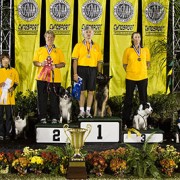 Wings earned her Utility Dog (UD) title before she was two (Derede handling) and in agility (Rob handling), won the 2009 USDAA Nationals Steeplechase in 2009 (at 2.5), and was 5th in Steeplechase at the USDAA Nationals in 2010. She has been a European Open finalist three times (2010, 2012, and 2014), and was alternate on the AKC Team to the FCI Agility World Championships in 2011.
Wings earned her Utility Dog (UD) title before she was two (Derede handling) and in agility (Rob handling), won the 2009 USDAA Nationals Steeplechase in 2009 (at 2.5), and was 5th in Steeplechase at the USDAA Nationals in 2010. She has been a European Open finalist three times (2010, 2012, and 2014), and was alternate on the AKC Team to the FCI Agility World Championships in 2011.
She has been in the USDAA top ten in almost every category from 2010 to 2016 (despite taking time off for three maternity leaves). She also placed 4th in the highly competitive 26″ class at the 2013 AKC Nationals. She is happy, outgoing, frighteningly smart, super-sweet, immensely powerful, fabulously athletic, FAST. With her, we have touched the sky.
Wings has been bred three times and produced very well, pups much like herself: smart, healthy, well-built, sweet, drivy, FAST. We will also continue her legacy by breeding certain outstanding relatives. Please check our “Litter Plans” page for more information.
Our Breeding Philosophy
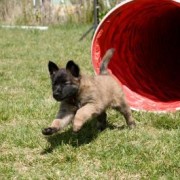 Given our own experiences with dogs lacking stable temperaments, good health, sufficient drive, or strong and athletic structure — when we made the decision to breed, these were the factors we wished to prioritize. We wanted dogs temperamentally confident and responsive for agility, with the drive to compete at the highest levels of agility, and with genetically good health and the structure to enable their bodies to do what their minds would want. We also, ideally, wanted to produce dogs who were a little smaller — on the small side of the standard — to better take the physical beating that a very competitive agility career would entail. So far, so good: we have been very happy with the character, build, health, and drive of our Haute Volée pups, and while we’ve had a couple who were a little taller, most are on the small side of the standard as we’d hoped.
Given our own experiences with dogs lacking stable temperaments, good health, sufficient drive, or strong and athletic structure — when we made the decision to breed, these were the factors we wished to prioritize. We wanted dogs temperamentally confident and responsive for agility, with the drive to compete at the highest levels of agility, and with genetically good health and the structure to enable their bodies to do what their minds would want. We also, ideally, wanted to produce dogs who were a little smaller — on the small side of the standard — to better take the physical beating that a very competitive agility career would entail. So far, so good: we have been very happy with the character, build, health, and drive of our Haute Volée pups, and while we’ve had a couple who were a little taller, most are on the small side of the standard as we’d hoped.
The best working-line Belgians exhibit incredible self-confidence and stability without losing their awareness of what is happening around them. This self-confidence creates dogs that don’t need their handler to deal with the world around them but who still strongly desire to be with you and work with you, a very strong Belgian trait. This is the type of dog that we are trying to produce: socially and environmentally confident yet still handler-focused, intense and high-energy but not “spun,” able to think in drive. Learn more about Working Line Tervuren
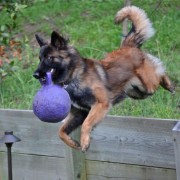 The same health issues that occur in show lines are present in working lines but tend to occur less frequently. This is particularly true for epilepsy, gastric carcinoma, and hip dysplasia. However, it seems likely that the prevalence of autoimmune issues, dilated cardiomyopathy, elbow dysplasia and others may be more equivalent to its occurrence in show lines. Of course, we do everything that we can to avoid these conditions. If you think that you are interested in an HV Terv puppy we ask, and insist, that you help us in tracking the health status of the puppies that we produce by having all appropriate health tests done on your puppy. This includes OFA hip and elbow radiographs and CERF (certification against inherited diseases of the eyes). Of those tests, the only that needs to be done more than once is the CERF test which should be done at 2 years, 6 years, and 10 years old.
The same health issues that occur in show lines are present in working lines but tend to occur less frequently. This is particularly true for epilepsy, gastric carcinoma, and hip dysplasia. However, it seems likely that the prevalence of autoimmune issues, dilated cardiomyopathy, elbow dysplasia and others may be more equivalent to its occurrence in show lines. Of course, we do everything that we can to avoid these conditions. If you think that you are interested in an HV Terv puppy we ask, and insist, that you help us in tracking the health status of the puppies that we produce by having all appropriate health tests done on your puppy. This includes OFA hip and elbow radiographs and CERF (certification against inherited diseases of the eyes). Of those tests, the only that needs to be done more than once is the CERF test which should be done at 2 years, 6 years, and 10 years old.
Since the working-line gene pool in the US is very small, we have spared no expense to meet and evaluate the best working-line males in Europe. The fathers of our first two litters were foreign dogs (a Swiss dog we flew over, and a French stud we flew ourselves and Wings to meet); until the selection of working-line tervs in the US is larger, we expect again to look to Europe for future mates for Wings. Knowing that the choices we make in breeding a litter affect in a very significant way the lives of each one of our puppy people, it has been a matter of course for us to extensively research and interview (by video and then always in person) possible studs to determine the very best mates for Wings.
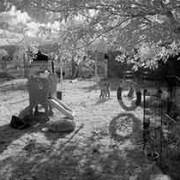 We want dogs temperamentally confident and responsive for agility, with the drive to compete at the highest levels of agility, and with genetically good health and the structure to enable their bodies to do what their minds would want.
We want dogs temperamentally confident and responsive for agility, with the drive to compete at the highest levels of agility, and with genetically good health and the structure to enable their bodies to do what their minds would want.
We raise our pups in a highly enriched environment, with miniature agility equipment available, multiple sounds and unstable surfaces, and extensive traveling and socialization with people and other dogs from an early age. We bottle-feed and hand-feed whenever possible, so that our pups go home clicker-trained, paper-trained, crate-trained, and knowing some basic impulse control like sit for your food/sit before being released from pen or crate. Our puppy people report their pups to be happy, confident, biddable, sweet-natured, resilient, and very high-drive dogs.
Having ourselves received little support from our first terv’s breeder, we also have been determined to be resources to our puppy people. Beyond our private email list where we can all share stories, problems, and triumphs, we provide extensive phone and email support, offer “puppy reunion” training get-togethers, and share websites, dvds, and books as we can. We are almost all serious agility competitors, so we have that tie in common too, and feel our little “Haute Volée community” to be a second family in many ways. It’s funny how, despite other differences, our shared love and admiration of these special dogs binds us together.

